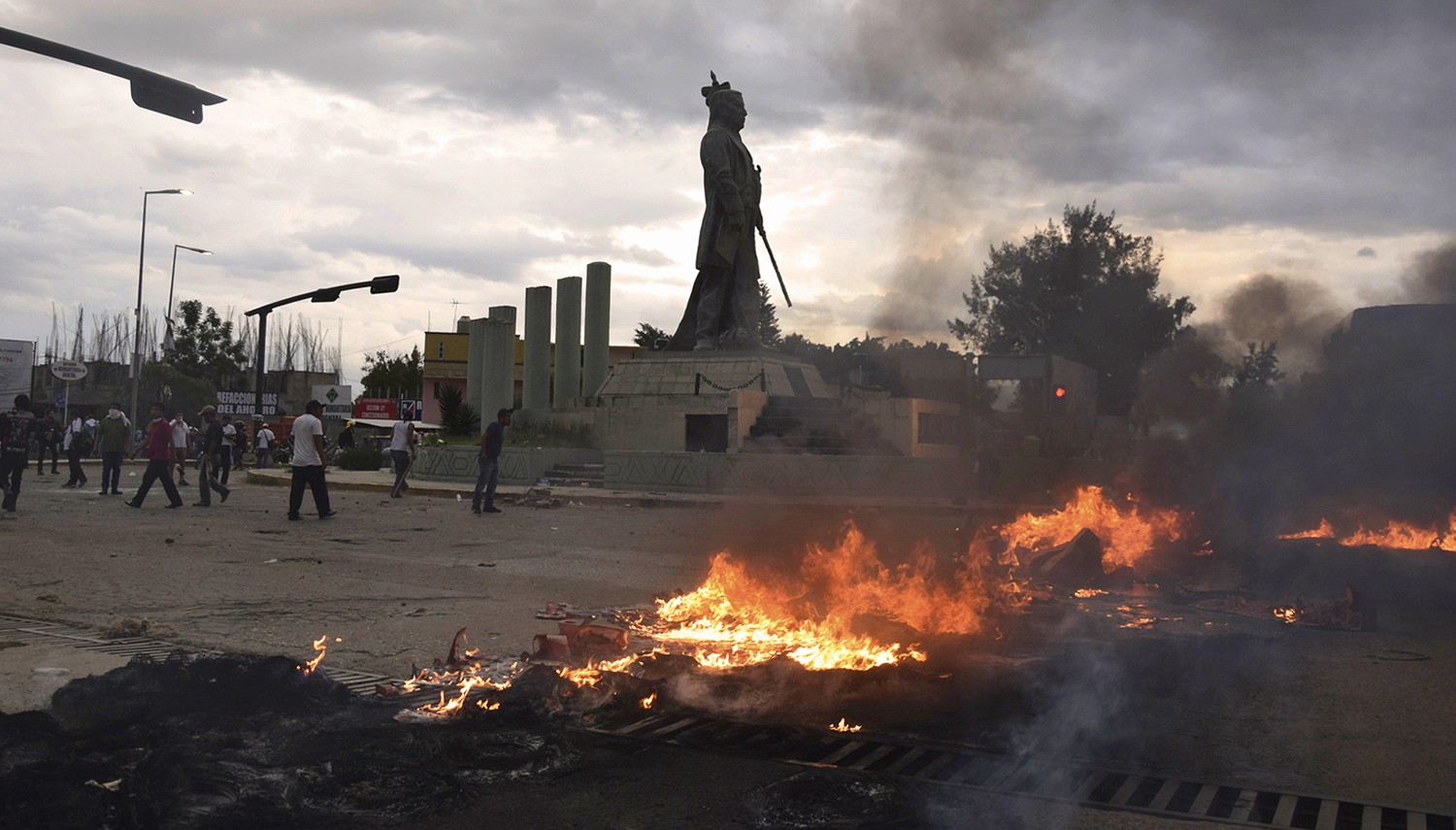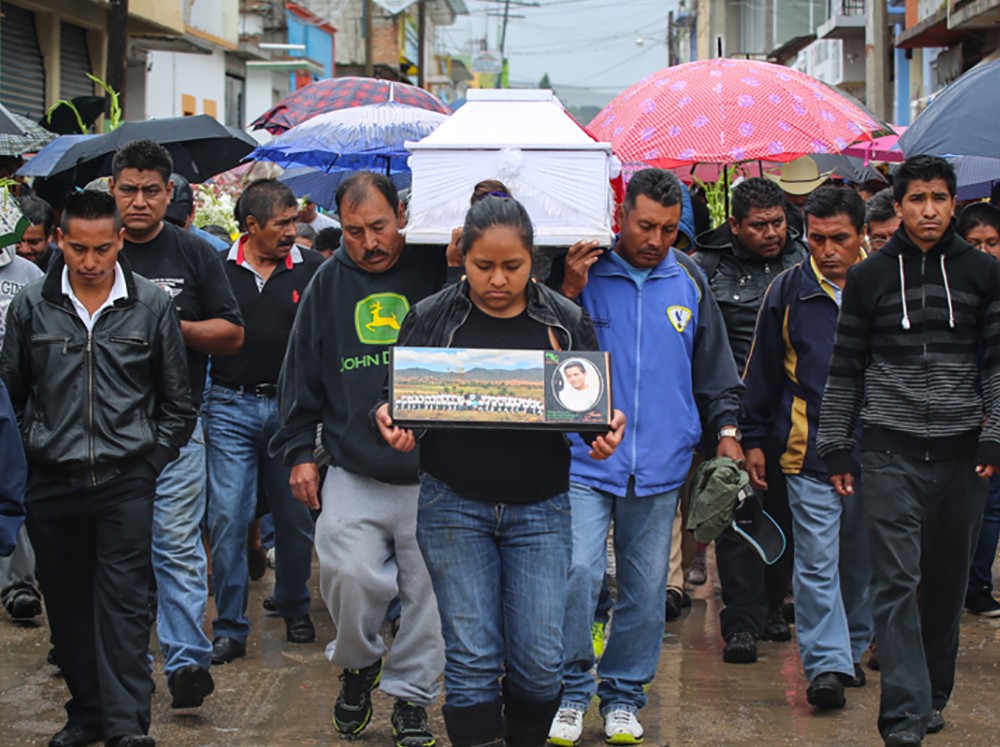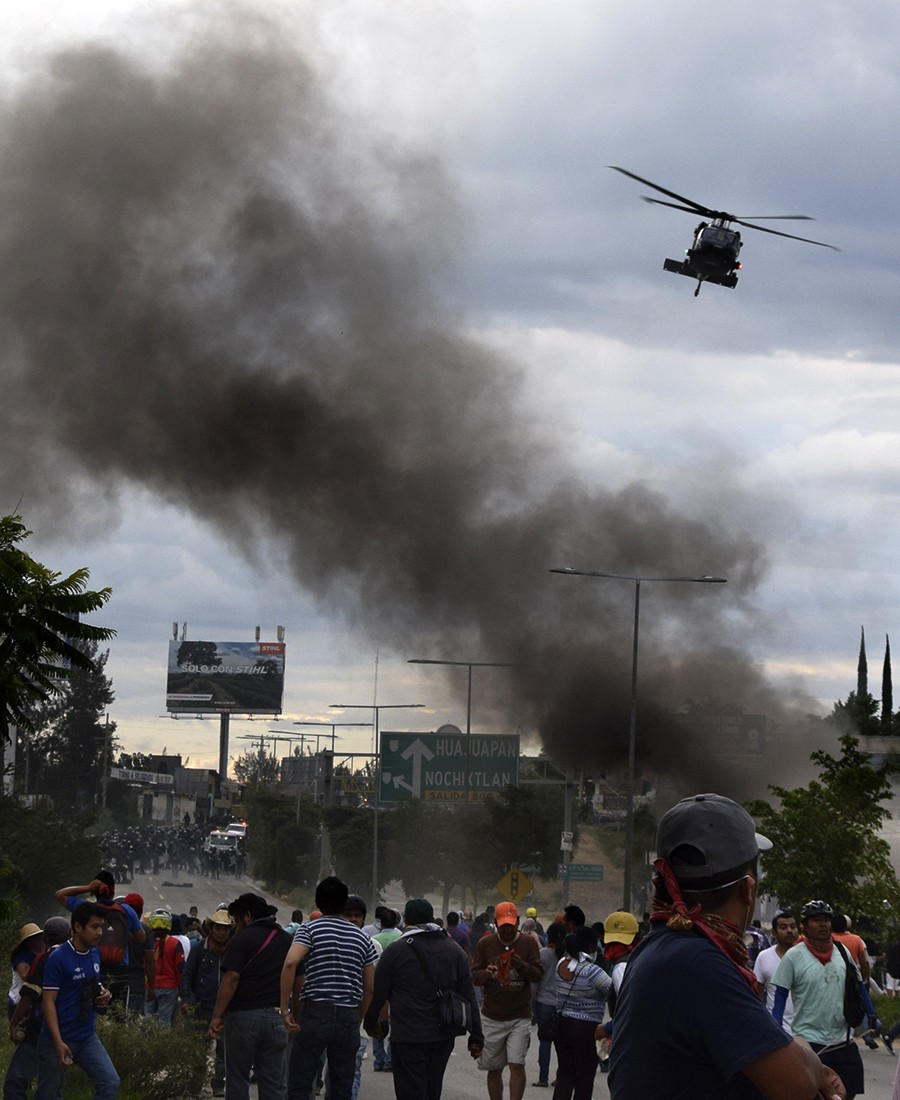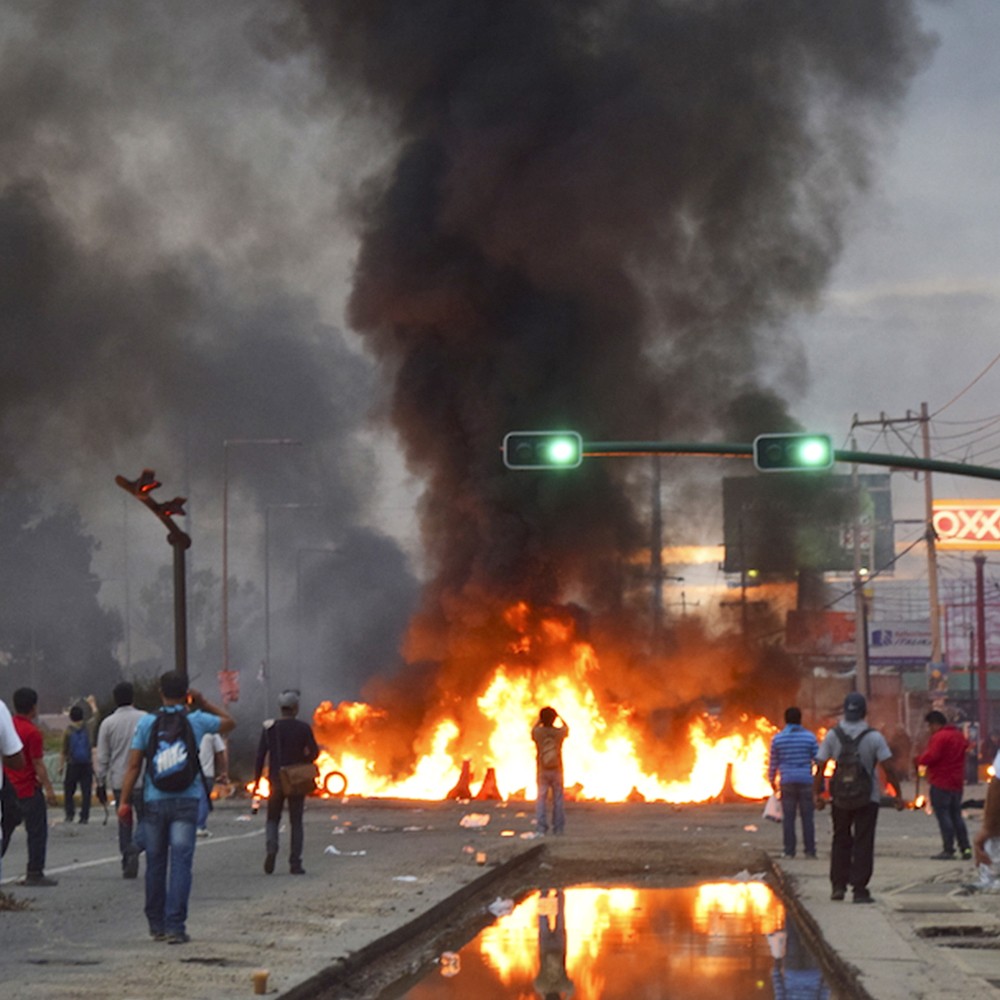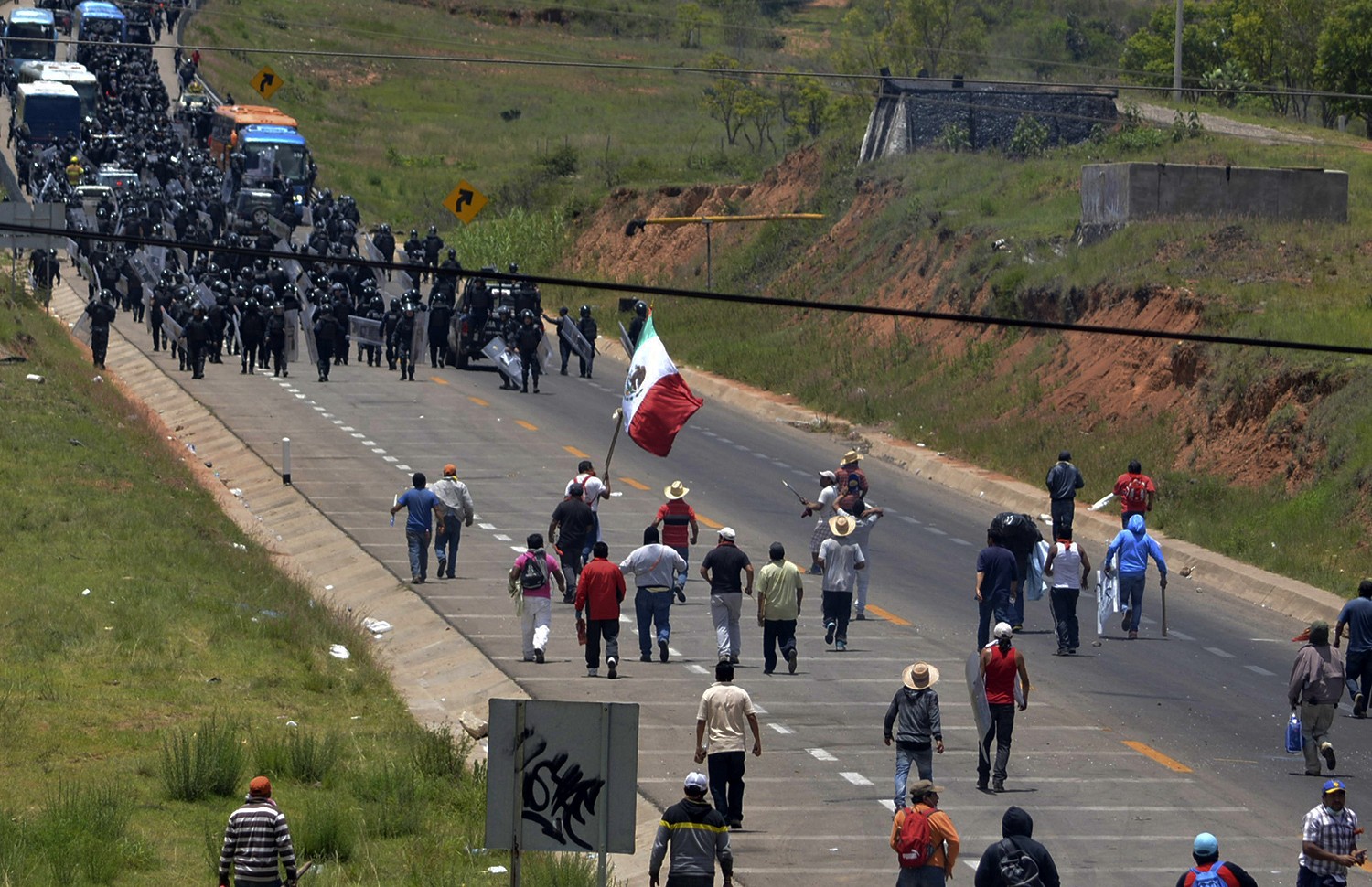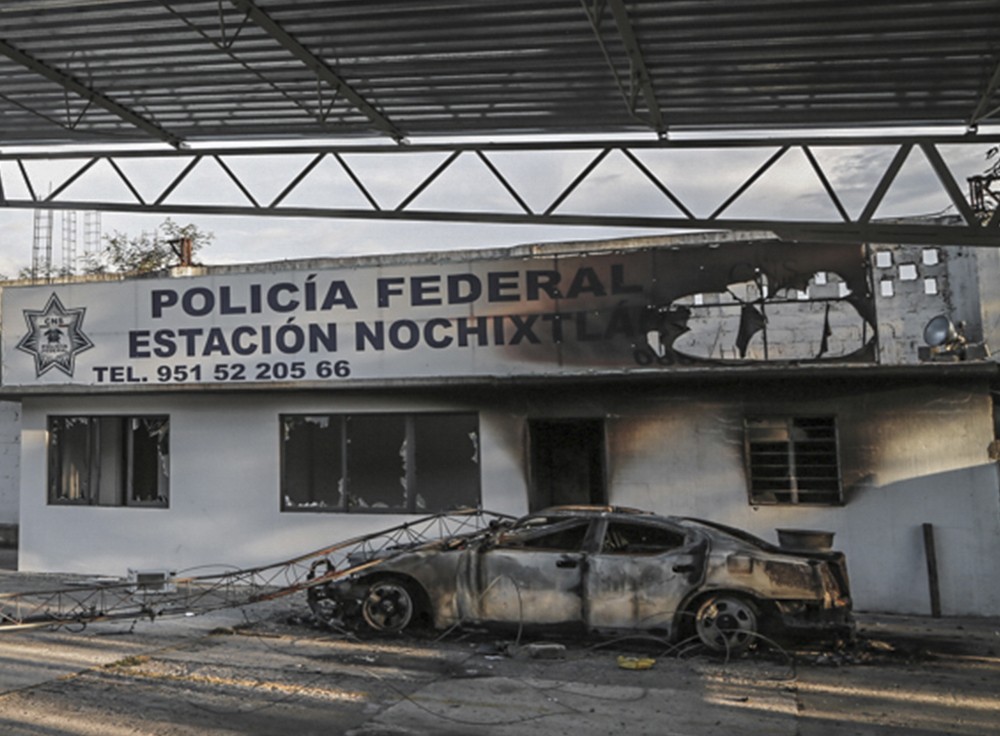Filed under: Analysis, Environment, Indigenous, Mexico, Repression, Southern Mexico
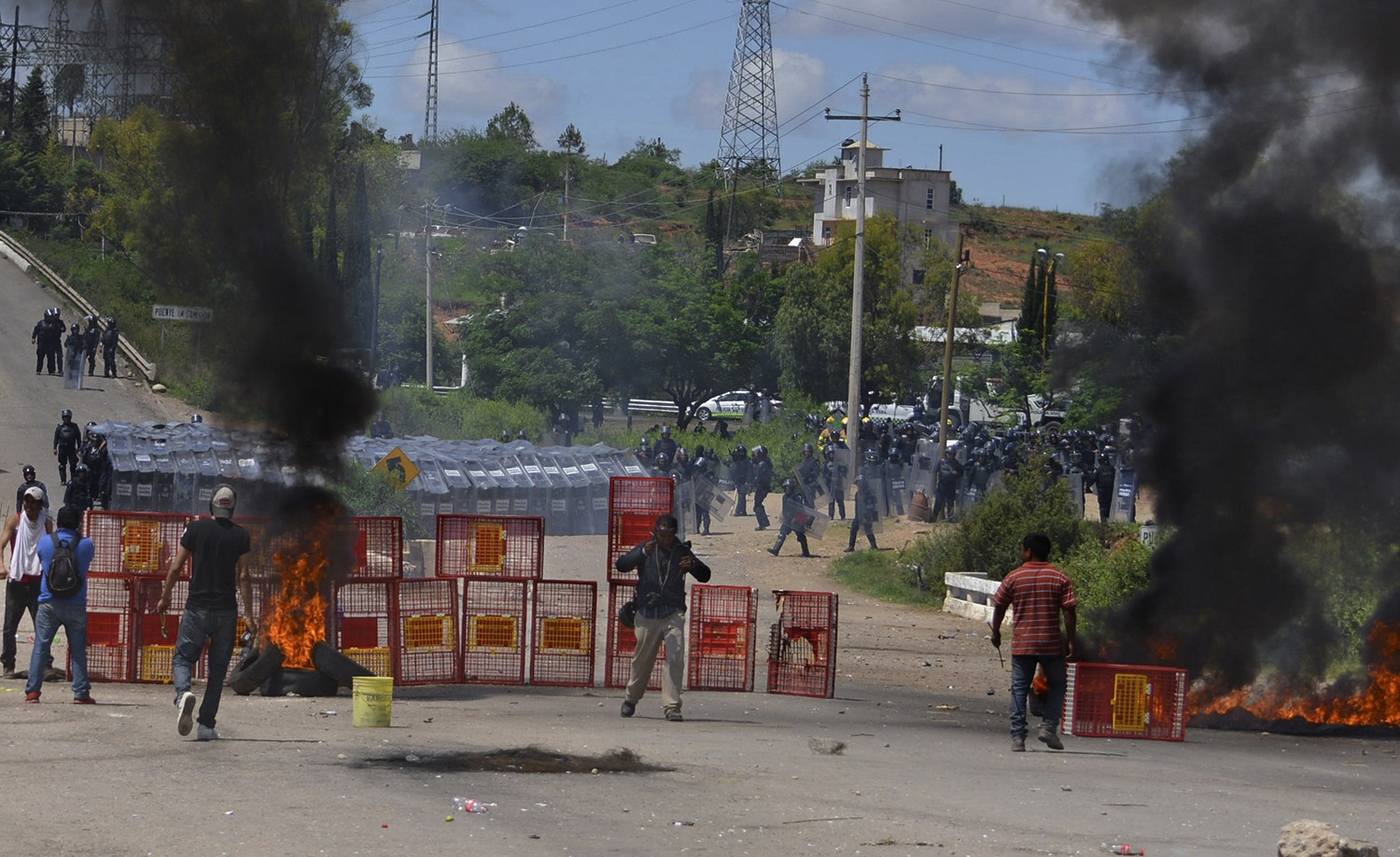
Please also visit the original microsite.
I. Massacre Carried Out on Top of Mineral Deposits
Beginning June 13, 2016, the Mixtec population blocks the way of federal forces arriving in Oaxaca to impose the Education Reform. On the morning of June 19, 2016, the blockade located by the town of Nochixtlán is removed. The majority of the inhabitants didn’t know that the site where the attack began, and the places where the violence of the operation ordered by the state government of Gabino Cué Monteagudo and the federal government of Enrique Peña Nieto would later spread, lie on top of or are a few kilometers away from different mineral deposits.
Once again, after a brief period of indifference, the eyes of the entire planet turned towards the southern state of Oaxaca; the roar of dozens of pistols and high-caliber weapons fired by police against the Mixtec population caught the world’s attention.
Outcome of a Massacre Denied by the Government:
KILLED
8
ARRESTED
27
PEOPLE HOSPITALIZED
137
HOSPITALIZED WITH BULLET WOUNDS
87
Source: “Oaxaca” Operation, June 19. Human rights violations report.
Three fireworks are fired from under the La Comisión Bridge – located at kilometer 178 on highway 190, which connects the city of Oaxaca with Mexico City – they pass several meters over it and go off. Their thunder is the alert signal people have been awaiting for six consecutive nights, confirming that government forces are approaching Santa María Asunción Nochixtlán, Oaxaca.
Around 7:30 in the morning on Sunday, June 19, 2016, combined troops from the Federal Police, National Gendarmerie, Transit Police, and State Police begin the attack on the population. In a few short minutes the air is saturated with tear gas. Just one hour after the offensive begins, the sound of gunfire echoes throughout the area.
The blood of hundreds of Mixtecs is spilled by police gunfire in Nochixtlán. The repression spreads to San Francisco Telixtlahuaca, San Pedro Huitzo, Hacienda Blanca and Viguera. Without knowing it, this blood falls over deposits of manganese, lead, copper, zinc, molybdenum, antimony, coal, iron, graphite, gold, and silver.
II. A Mining Allocation of More Than One Million Hectares
The wind over the Mixteca region spreads the poisonous chemical smoke produced by the projectiles, Model 6230 Riot CS Smoke made by Combined Tactical Systems (CTS); the echo of the shots from federal and state weapons – G3, AR-15, CZ P-09, CZ 805 BREN A1 assault rifles, and pistols of various calibers – reverberates in the hills and on the horizon of Nochixtlán; the gas and the sound of gunfire cover the Mixtec territory, allocated for mining under the auspices of the Mexican Geologic Service (SGM).
Yalid Jiménez Santiago, Anselmo Cruz Aquino, Jesús Cadena Sánchez, Óscar Luna Aguilar, Óscar Nicolás Santiago, Omar González Santiago, and Silvano Sosa Chávez are murdered a scarce 2.3 kilometers from one end of the enormous 511,303 hectare claim that’s set to be explored; their blood is shed over deposits of manganese and graphite.
The corner formed by Jazmines and Abraham Castellanos streets, in the Emiliano Zapata neighborhood of Nochixtlán, is the exact point where one of the edges of the plot destined for mineral exploration is located. The town that thousands of Mixtecs defend to keep the police from invading their homes and territory, to protect their children and their people, will soon have another battle to fight, this time against mining companies. In that moment they don’t know it.
This can be confirmed based on Mining Allocation Deed number 216, published on July 1, 2010 in the Official Journal of the Federation [the state publication where that day’s federal laws, acts and orders are reprinted]. It refers to the “Hidalgo Oeste” claim spanning two states, Puebla and Oaxaca, naming the SGM as the title holder and lists, as written: “The municipalities of: Asunción Nochixtlán, Concepción Buenavista, Concepción Papalo, among others Oaxaca; Ajalpan, Altepexi, Caltepec, among others Puebla.”
The mining allocation extends to less than three kilometers from where the governmental assault began, very close to a junction that connects to one of the entrances to Nochixtlán. It is there that the Federal Police barracks is located, which was burned by an enraged population during the repression on June 19.
In addition to being territory under exploration for mineral extraction by SGM, Asunción Nochixtlán is also where title 158333, granted to the company CIA Minera Parral y Anexas, SA de CV is located. The mining claim is called “El conjunto cinco” and is currently canceled. This mining concession encompasses 50 hectares for the exploitation of manganese within the municipality’s territory.
The municipalities bordering Nochixtlán also have mining concessions. Two such titles appear in the Mining Administration System registered under the name of Asunción Nochixtlán:
- Title 205906 is situated in San Francisco Jaltepetongo, a municipality close to Nochixtlán, delimiting 20 hectares of the “Verónica” claim on behalf of Rogelio de Haro González. The concession is currently canceled; it was issued October 23, 1997 and in the current data there is no indication of what material the concession is designated for.
- In the municipality of Santa Inés de Zaragoza, mining concession title 233927 encompasses 60 hectares of territory. It was issued April 24, 2009 and refers to the Gabriela mining claim, in search of gold, silver, and trisodium phosphate and owned by Marcos Vázquez Arteaga.
The Mining Sector in Mexico
437000 million
LITERS OF WATER USED IN 2014
18%
OF MEXICAN TERRITORY CONCESSIONED UP TO 2015
$5
MEXICAN PESOS PAID FOR THE FIRST YEAR OF A CONCESSION
Source: Mexican Chamber of Mining (CAMIMEX) – CartoCrítica (Research, maps, and data for civil society).
III. Blood Spilled on Graphite Destined for Tesla
The Mixtec peoples confronted federal and state troops, reinforced by land and two combat helicopters, with strong and decisive resistance for seven hours. The enraged uniformed multitude, dressed in black and dark blue, flees Nochixtlán towards Oaxaca in shaken disorder. The first killings are reported in the media; the repression doesn’t cease and there are confrontations at the toll booth between San Francisco Telixtlahuaca and San Pablo Huitzo.
After attacking Nochixtlán, the federal police follow highway 190 en route to the city of Oaxaca, arriving at the San Pablo Huitzo toll booth located a little less than a half hour from the city. Here they have held back the residents, first to let their reinforcements through and hours later to have an escape route. The inhabitants block the way with barricades they have installed on the highway. A kilometer and a half away, at least 10 mining concessions can be found, some even on top of others.
Companies With Concessions of Greater Territorial Extension in Oaxaca
511303 ha
PROYECT HIDALGO-OESTE
13160 ha
MITTAL STEEL MOLINOS
7200 ha
MITTAL STEEL MOLINOS
Source: Mexican Chamber of Mining (CAMIMEX) – CartoCrítica (Research, maps, and data for civil society).
ha = Hectare
The 50-year concession granted to José Pérez Reynoso y Socios belongs to the Canadian company Big North Graphite, through Grafito de México SA de CV. It’s called the “El Tejón” mining claim, located approximately 38 kilometers northwest of Oaxaca city in the town of San Francisco Telixtlahuaca and spanning a surface area of 500 hectares for the extraction of gold, silver, lead, copper, zinc, and graphite.
Underneath its lands, San Francisco Telixtlahuaca shelters gold, silver, copper, and an important part of an abundant deposit of graphite. Big North Graphite – a Canadian company owned by Flinders Resources since September 2014 – will supply the Swiss company TESLA, a world leader in the automotive sector. Graphite is the mineral that attracts the most interest in this area.
According to a report published by the National Inflation Association – “Preparing Americans for Hyperinflation” – Big North Graphite, which appears under the acronym NRT, announced on December 19, 2013 that it had filed a letter of intent to acquire Grafitos de México, the owner of the “El Tejón” property.
The report states that the concession is in an area with good infrastructure and a nearby available labor source. NRT believes that this project will be an excellent complement to its current graphite projects in the state of Sonora. Operating at full capacity, this mine will produce an estimated 4,400 tons of graphite a year.
“Technical Report 43-101 El Tejon Graphite Project” – put out by Mammoth Geological Ltd, based in Vancouver, Canada – notes that Big North Graphite, MAG Exploration Services and César Javier Guajardo closed a deal on January 31, 2014 for Big North Graphite to acquire all assets of Grafito de México SA de CV, owned by César Javier Guajardo Villareal. This mining concession is a clear example of the multiple economic interests involved in just one project.
According to a commercial report by the General Mining Coordination dated December 2016, graphite appears abundantly in Oaxaca and its greatest concentration lies in the central valleys, principally Telixtlahuaca and extending to Cuicatlán, Ejutla, Nochixtlán, Tlaxiaco, Zimatlán, Etla, Yucucundo and Huitepec.
The largest concession in the area – title 229853, in the name of Mittal Steel Molinos SA de CV – spans the municipalities of Huitzo and Telixtlahuaca, with a surface area of 13,160 hectares. It is registered to San Jerónimo Sosola and called MS-Oaxaca IV, designated for initial exploitation of iron.
It was right on one of its edges where the confrontation with federal troops took place, with Cougar and Black Hawk helicopters flying maneuvers over the conceded territory after gliding off from the site of the massacre.
Endeavour Silver Corp, a Canadian company, has a 20-hectare concession in San Francisco Telixtlahuaca that is currently canceled. It is under the name of Minera del Cubo SA de CV, which the company uses for its dealings with government agencies in Mexico.
IV. On the Outskirts of Oaxaca, Iron and Death
The City of Resistance seems to defy the cycle of time: June 14, 2006/June 19, 2016 – the city entrance that once flaunted a challenging “Welcome Federal Police” painted on the asphalt impatiently awaits the arrival of federal troops and state police.
The morning and midday hours pass by tensely in the City of Resistance. Not in 2006, nor ten years later, is the majority of the population aware that 6 kilometers from the intersections of Hacienda Blanca and Viguera lies a mining concession, which under title number 229875 grants 7,200 hectares to the company Mittal Steel Molinos for iron exploitation. The title is registered in the town of Santa Tomas Mazaltepec and also encompasses the towns of San Felipe Tejalapam, San Andrés Zautla, Nazareno Etla, Soledad Etla and San Lorenzo Cacaotepec.
The young man Azael Galán Mendoza is killed six kilometers from the border of this mining concession by a bullet fired by a state police officer. While the sun is setting, the repression continues at the Viguera intersection.
Eight days before the Nochixtlán massacre, the state government of Gabino Cué Monteagudo and the federal government of Enrique Peña Nieto launch an offensive to evict the teachers’ protest encampment, located at the Oaxaca State Institute of Public Education (IEEPO). After the eviction, which left dozens injured by tear gas and more than 2 km of the city of Oaxaca saturated with it, several were wounded by the impacts of the gas canisters fired at people’s bodies and numerous teachers were beaten by police.
Among them is the teacher José Caballero Julián, who passes away on July 5 after suffering from his wounds for more than 20 days. Caballero was originally from the town of San Antonio Huitepec, where an active mineral concession in the name of Arco Explorations, SA de CV spans a surface area of 20,546 hectares in search of lead, gold, silver, and copper. The concession, referred to by the claim name “La luna,” is mining title 238876, granted November 8, 2011 by the General Mining Coordination of the Ministry of the Economy and valid until November 7, 2061.
Industrial Minera México is also in the list of companies that have concessions in the Mixteca region. It seeks to extract iron, molybdenum, manganese and antimony from the lands where Silvano Sosa Chávez was born, one of the people killed in Nochixtlán who had arrived to support his Mixtec brothers. He was from San Pedro Ñumi, where Industrial Minera México has been granted title 227428, an allocation of 6,172 hectares that make up the claim the company has called “Mixteca 1.”
Amidst the state repression against the teachers and Mixtec communities who rejected the Educational Reform, radio broadcaster Salvador Olmo was murdered on June 26, 2016 in Huajuapan de León in an attack carried out by the municipal police. He was tortured and then mowed down by a police pickup truck. Huajuapan de León is also territory allocated to mining exploration since September 1st and 2nd, 2011, under titles 239, 240, 243 and 244, spanning 19,585 hectares in total.
V. The Incursion of Mining in Oaxaca
Some of the most well-known companies worldwide – to which concessions in Oaxaca have been granted – are the same companies that have been responsible for forced displacement, the disappearance of entire communities, extractivism, labor exploitation, harmful impacts on health, and even the murder of miners in the north of Mexico.
The names of the owners of these companies are practically unknown. Outside of the media that specialize in aggrandizing their personas and the valiant work that some journalists have taken on to denounce their noxious activity, their presence is almost completely off the radar. They don’t even have to worry about setting foot in the territories they seek to appropriate, just like the Spanish kings who never had to cross the sea to steal the gold and silver of what is today known as America.
No account of the terror that existed in Oaxaca on June 19, 2016 is more striking than the drawings and stories of the children of Nochixtlán. Even if the attack limited itself to putting down the teachers’ resistance to the Educational Reform, the significance of launching a disproportionate attack against one of the gateways to the Mixteca region of Oaxaca is much broader.
Leaving a message of repression branded into the skin of the Mixteca through a massacre like that of June 19 is an indispensable requirement for the advance of transnational mining companies over the coveted mineral deposits in the region. Santiago Ayuquililla, Chilixtlahuaca and Huajuapan de León are two more territories allocated for the search of gold and silver, and Santiago Yosondúa is the access point to the largest iron deposit on the planet, to name just a few of the concessions found in Oaxacan territory.
Mining explorations have by now searched every last gram of earth to calculate how many millions of tons of minerals they can extract; however, the fact that thousands of Mixtecs would not be intimidated in the face of repression was neither in the government’s calculations nor in the transnational mining companies’ profit ambitions.
The blood spilled on June 19, 2016, on top of mineral deposits, is the latest warning sign for the peoples of the Mixteca and Oaxaca to organize themselves in the face of the theft of their lands that mining companies, backed by the government, seek to carry out; a call to show that the blood of those who fell in 2006 and 2016 has not been shed in vain.


